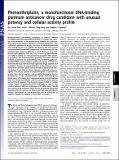Phenanthriplatin, a monofunctional DNA-binding platinum anticancer drug candidate with unusual potency and cellular activity profile
Author(s)
Park, Ga Young; Wilson, Justin Jeff; Song, Ying; Lippard, Stephen J.
DownloadPark-2012-Phenanthriplatin, a Monofunctional DNA-Binding Platinum Anticancer Drug Candidate.pdf (472.4Kb)
PUBLISHER_POLICY
Publisher Policy
Article is made available in accordance with the publisher's policy and may be subject to US copyright law. Please refer to the publisher's site for terms of use.
Terms of use
Metadata
Show full item recordAbstract
Monofunctional platinum(II) complexes of general formula cis-[Pt(NH3)2(N-heterocycle)Cl]Cl bind DNA at a single site, inducing little distortion in the double helix. Despite this behavior, these compounds display significant antitumor properties, with a different spectrum of activity than that of classic bifunctional cross-linking agents like cisplatin. To discover the most potent monofunctional platinum(II) compounds, the N-heterocycle was systematically varied to generate a small library of new compounds, with guidance from the X-ray structure of RNA polymerase II (Pol II) stalled at a monofunctional pyriplatin-DNA adduct. In pyriplatin, the N-heterocycle is pyridine. The most effective complex evaluated was phenanthriplatin, cis-[Pt(NH3)2(phenanthridine)Cl]NO3, which exhibits significantly greater activity than the Food and Drug Administration-approved drugs cisplatin and oxaliplatin. Studies of phenanthriplatin in the National Cancer Institute 60-cell tumor panel screen revealed a spectrum of activity distinct from that of these clinically validated anticancer agents. The cellular uptake of phenanthriplatin is substantially greater than that of cisplatin and pyriplatin because of the hydrophobicity of the phenanthridine ligand. Phenanthriplatin binds more effectively to 5′-deoxyguanosine monophosphate than to N-acetyl methionine, whereas pyriplatin reacts equally well with both reagents. This chemistry supports DNA as a viable cellular target for phenanthriplatin and suggests that it may avoid cytoplasmic platinum scavengers with sulfur-donor ligands that convey drug resistance. With the use of globally platinated Gaussia luciferase vectors, we determined that phenanthriplatin inhibits transcription in live mammalian cells as effectively as cisplatin, despite its inability to form DNA cross-links.
Date issued
2012-07Department
Massachusetts Institute of Technology. Department of ChemistryJournal
Proceedings of the National Academy of Sciences of the United States of America
Publisher
National Academy of Sciences (U.S.)
Citation
Park, G. Y. et al. “Phenanthriplatin, a Monofunctional DNA-binding Platinum Anticancer Drug Candidate with Unusual Potency and Cellular Activity Profile.” Proceedings of the National Academy of Sciences 109.30 (2012): 11987–11992. Web.
Version: Final published version
ISSN
0027-8424
1091-6490